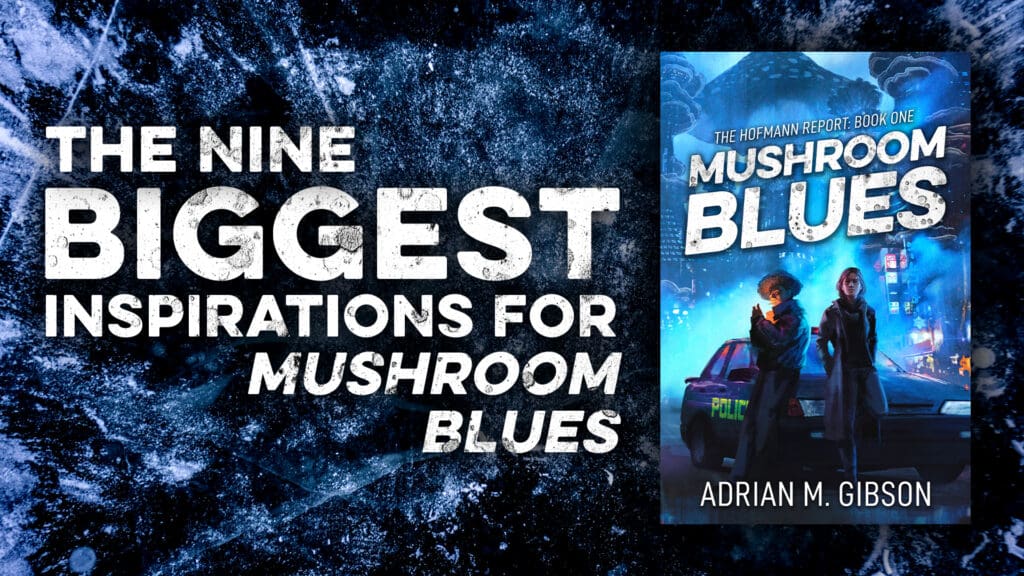
My debut novel Mushroom Blues is out in just one week, and I am so excited to share the world of Neo Kinoko and The Fungalverse with readers. Humans are very good at accumulating information, and when it comes to creativity, everything an individual spews out is an amalgamation of the things they consume that inspire them. From movies to TV shows, video games, and books, there are just so many incredible stories and properties out there. So, to give all of you a deeper sense of Mushroom Blues, I’ve compiled a list of my nine biggest inspirations for this story, its world, and its characters. Scroll down to check out the full list before the book launches on March 19th!
This list is part of the Mushroom Blues virtual book tour. Check out the full tour here.
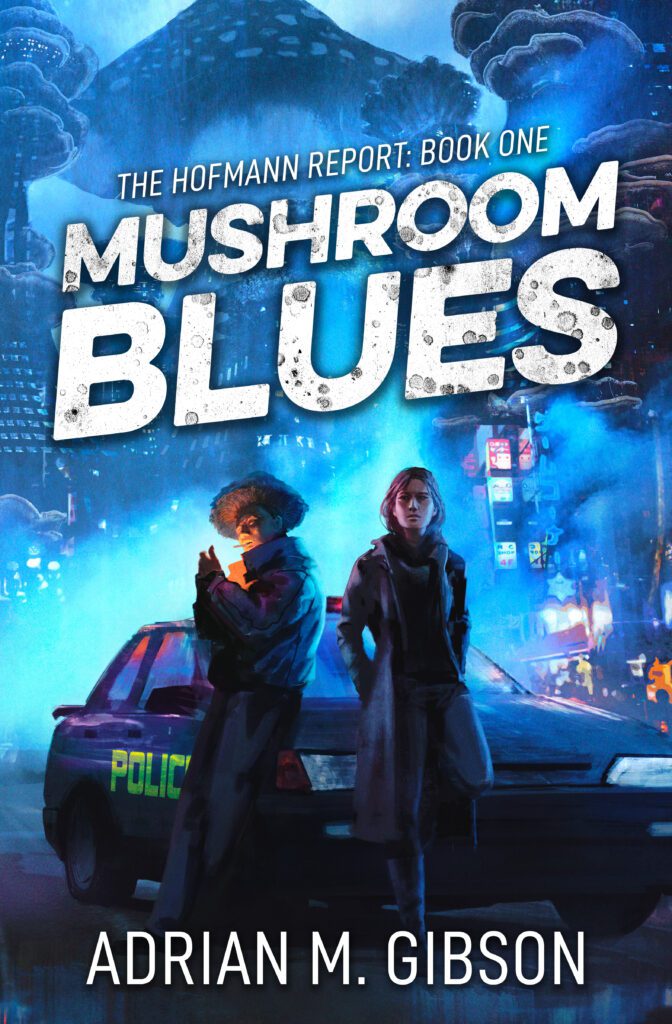
🍄 BOOK INFORMATION 🍄
Book/Author: Mushroom Blues (The Hofmann Report #1) by Adrian M. Gibson
Cover Artist: Felix Ortiz | Instagram | Artstation
Typography/Cover Design: Adrian M. Gibson
Genre: Science Fiction / Mystery / Police Procedural / Dystopia / Fungalpunk
Release Dates: Paperback and eBook (March 19), hardcover (April 2), audiobook (April 16)
Soundtrack composed/mastered by: Sporer
Available formats: Digital, limited edition cassette
🍄 BOOK BLURB 🍄
BLADE RUNNER, TRUE DETECTIVE and DISTRICT 9 meld with the weird worlds of JEFF VANDERMEER, PHILIP K. DICK and CHINA MIÉVILLE in Adrian M. Gibson’s fungalpunk noir debut.
TWO YEARS AFTER a devastating defeat in the decade-long Spore War, the island nation of Hōppon and its capital city of Neo Kinoko are occupied by invading Coprinian forces. Its Fungal citizens are in dire straits, wracked by food shortages, poverty and an influx of war refugees. Even worse, the corrupt occupiers exploit their power, hounding the native population.
As a winter storm looms over the metropolis, NKPD Detective Henrietta Hofmann begrudgingly partners up with mushroom-headed patrol officer Koji Nameko to investigate the mysterious murders of Fungal and half-breed children. Their investigation drags them deep into the seedy underbelly of a war-torn city, one brimming with colonizers, criminal gangs, racial division and moral decay.
In order to solve the case and unravel the truth, Hofmann must challenge her past and embrace Fungal ways. What she and Nameko uncover in the midst of this frigid wasteland will chill them to the core, but will they make it through the storm alive?
🍄 NINE INSPIRATIONS 🍄
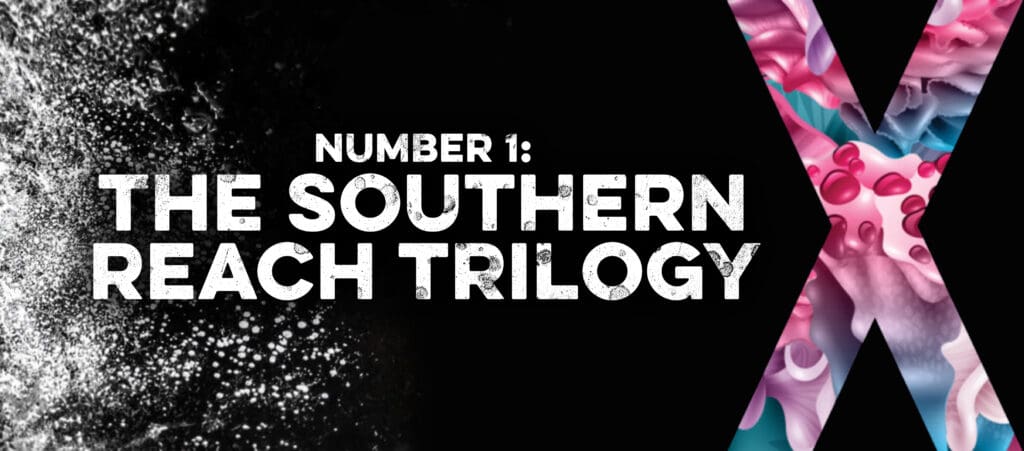
WHAT IT INSPIRED: Creepy, colonizing atmosphere and evocative prose.
Jeff VanderMeer’s work has been so influential on me as a whole, that it was difficult to narrow this down to just one series. While his Ambergris trilogy and its fungal people were hugely inspirational for Mushroom Blues (Finch, in particular), I’d already given those books a shoutout in my list on Before We Go Blog titled “Fungi in Fiction.” So, I also wanted to reflect on The Southern Reach Trilogy, which includes Annihilation, Authority and Acceptance.
These books are an absolute masterclass in atmosphere, tossing readers into the uncanny, surreal Area X. Nature itself is insidious, and nothing is at it seems. There is an eerie atmosphere in these books that VanderMeer evokes so well through rich, poetic prose and unsettling description. The way things creep and crawl and consume—it’s gorgeous and strange. I took so much from that, writing the city of Neo Kinoko and its mushroom-headed denizens with the approach of using language to create a claustrophobic, colonizing atmosphere, brimming with vivid descriptions of mold and mycelium. Almost as if the very environment itself could infect you.
SIDE NOTE: Annihilation is the book that single-handedly made me want to be a professional fiction writer.
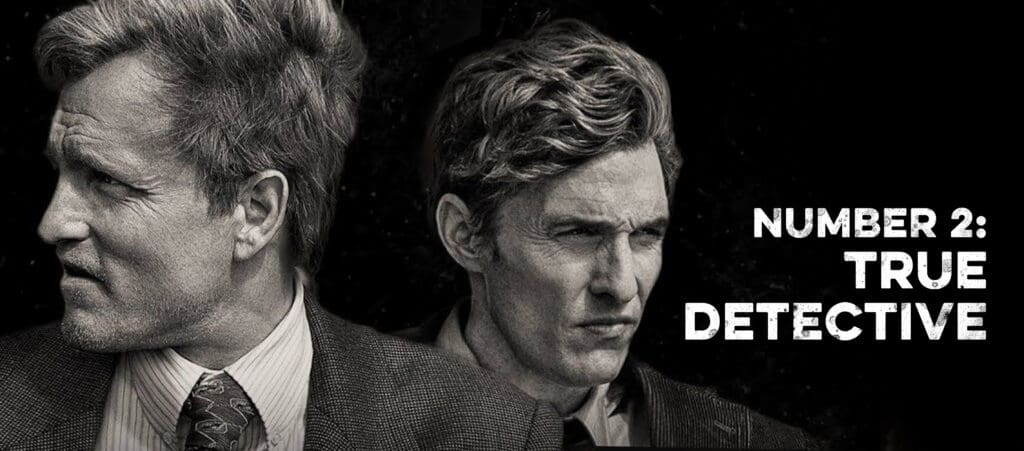
WHAT IT INSPIRED: The troubled buddy cop dynamic and the Gothic mood.
The first season of True Detective completely upended my conception of what a police procedural could be like on TV. Instead of the “crime of the week” approach of shows like Criminal Minds, NCIS and Bones, True Detective show delved deep into a single case that utterly consumed its investigators. Not only that, it presented the “buddy cop” dynamic in a way that was so compelling, with Woody Harrelson’s Marty Hart and Matthew McConaughey’s Rust Cohle fundamentally challenging each other’s perceptions of their personal lives and the philosophies about the world around them.
I adored every minute of this season, from the tense Gothic mood of its Louisiana setting to the way its cinematography and music added so much to the narrative’s oppressive anxiety and overall pacing, as well as the impact of its unraveling investigation and disturbing killer. Mushroom Blues and its main characters Henrietta and Koji pull heavily from True Detective‘s balance between police procedural expectations, complex character dynamics, and moments where the mood elicits feelings of discomfort that veer into the surreal.
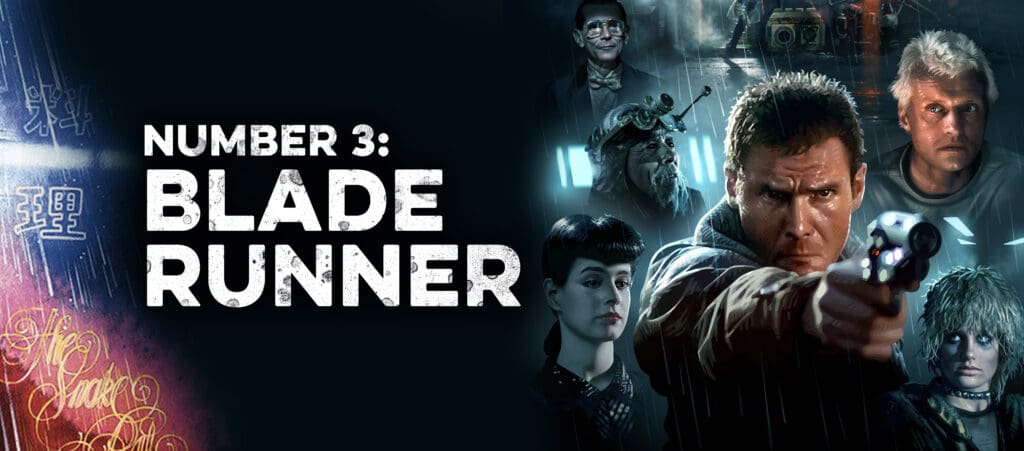
WHAT IT INSPIRED: Morally gray world and characters, cyberpunk aesthetics and a divided society.
Blade Runner is one of my favorite movies of all time. It’s also based on a book, Do Androids Dream of Electric Sheep?, that helped me rediscover my love for sci-fi and fantasy in my early twenties. But the movie accomplished things that the book did not (and vice versa), specifically presenting viewers with a morally gray world that is so iconic in the way it delivers worldbuilding through aesthetics and characters.
Rick Deckard is a character that so many of us remember. The way he traverses the apocalyptic future (now past) of Los Angeles allows us to glimpse the extremes of this divided society. There are those who bask in wealth, corporations that puppeteer the masses, destitute homeless and those struggling to survive, as well as androids who are hunted and slaughtered. I’ve always appreciated how deftly the film infuses its bleak, rainy, neon-soaked world with moments of humanity, despite the darkness that permeates the city and its populace. For Mushroom Blues and the city of Neo Kinoko, I tried to imbue it with layers of darkness, humanity, moral complexity and visual aesthetics that could pull the reader in more and more. There are those living in squalor, humans who oppress the fungal people, gangsters who thrive in a post-war milieu, and a corrupt police and military. Essentially, diversity of perspective creating richness of setting, and I have Blade Runner to thank for that.

WHAT IT INSPIRED: A gruff female lead detective, a complicated personal life and community dynamics.
HBO’s Mare of Easttown really caught me by surprise. I stumbled across it at random, but ended up binging the entire season. Kate Winslet in particular absolutely nailed her lead role in the show. Set in a small town in Pennsylvania, this contemporary police procedural does an incredible job of balancing the social dynamics of a broken community with the enticing mystery of a brutal murder. This is in intimate story with low stakes, and it’s all the better for it.
Winslet brings a dynamism to the character of Mare, delivering subtle shifts in her character as she navigates different circles. On one hand, she is a gruff detective, conflicted when she has to treat her neighbors, friends and family like potential suspects. On the other, she is a flawed mother in a dysfunctional family, where divorce and anger loom heavy. Mare was the direct inspiration for my main character in Mushroom Blues, Henrietta Hofmann. It was so beneficial for me to have a clear example of a strong female lead, one who was simply surviving in the mire of social pressures, past traumas, motherly instincts and investigative duties.
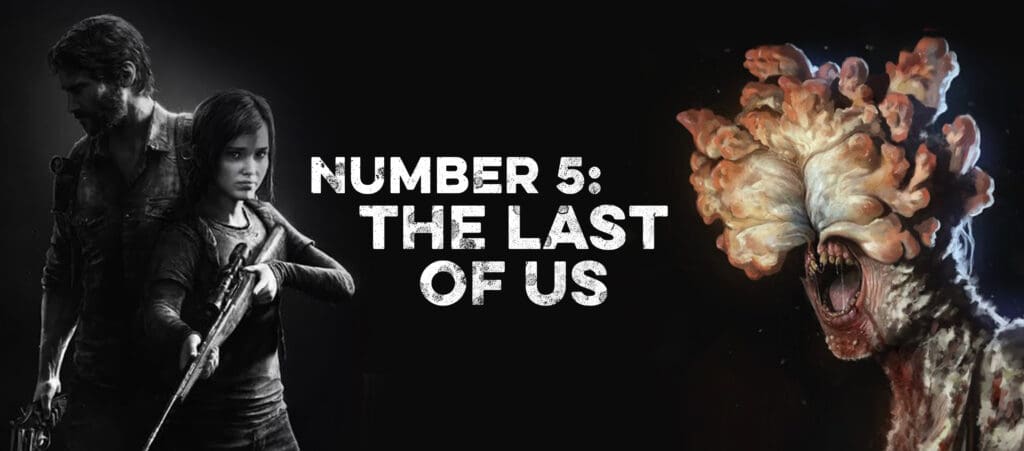
WHAT IT INSPIRED: Fungal body horror and the pervasive nature of fungi.
When I played the original The Last of Us video over a decade ago, I was floored. The graphics and gameplay mechanics. The atmosphere and story. But what truly captivated me were the fungal zombies. To see how a real fungi (Ophiocordyceps unilateralis, specifically) could infect humans was terrifying in its various manifestations. Spores permeating the air. Clicker zombies shambling around an environment, reacting with spine-tingling aggression to any sound. Dead bodies, entombed in mold and mushrooms. It had colonized almost every aspect of this fictional world, and it was both repulsive and fascinating at the same time.
The pervasive nature of fungi across this series, from the first game and its sequel to the HBO television show, really struck me—it was baked into the world and the narrative and the characters so completely. For Mushroom Blues, fungi is so integral to every aspect of the story. It’s also the foundation for The Fungalverse shared universe as a whole. I knew that to present mushrooms in this way, it had to be fully integrated into my representation of the fungal people, their society, their biology, their customs, their outlooks on life, and so much more. But there also had to be displays of fungi as both beautiful and terrifying. And nothing accomplishes that better than a mycophobic main character experiencing fungal body horror in various stomach-churning ways.
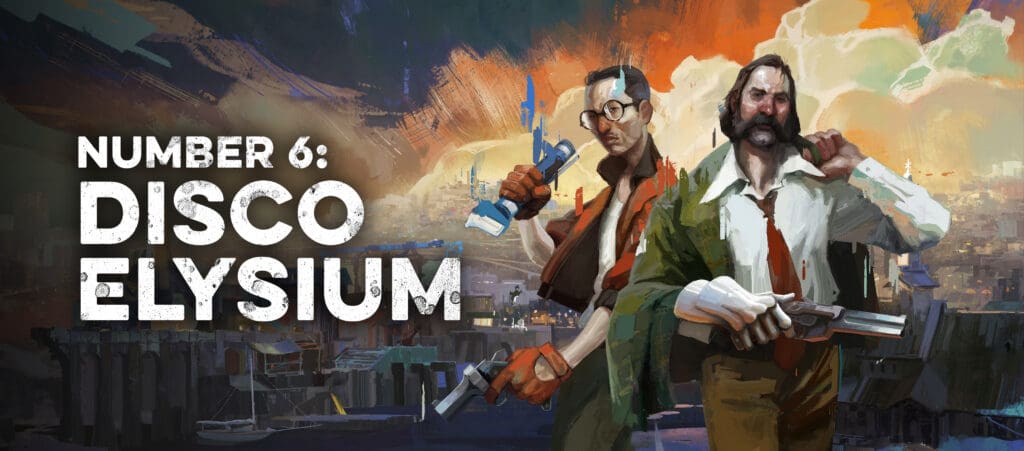
WHAT IT INSPIRED: Revolution/war, a broken protagonist and an expansive secondary world.
Adding another video game to the mix, I need to talk about Disco Elysium. This acclaimed non-traditional RPG is so freakin’ good, and one of the most unique gaming experiences I’ve ever had. There isn’t much combat in Disco Elysium, but I believe that’s to its benefit. Putting you in the shoes of detective Harrier “Harry” Du Bois, gameplay involves resolving situations through skill checks, dialogue trees and other core systems. But the coolest aspect of it is how those systems reflect the shattered nature of the protagonist’s psyche. Harry is deeply flawed, traumatized and alcoholic. Hell, the game starts out with you passed out in a hotel, hungover and unable to remember anything.
This amnesiac framework is perfect for allowing the world to unfurl slowly. And what a world it is. Decades prior, the capital of Revachol succumbed to a revolution, one that tore apart the fabric of the city. The district of Martinaise, where the game takes place, is richly imagined in a gorgeous, painterly graphical style—it’s grimy and dark, but also alluring. There is expansive history to this world, too, as the developers mapped out thousands of years of its history.
My thinking for Mushroom Blues and the broader Fungalverse pulled a lot from my experiences with Disco Elysium. Although not nearly as in-depth as six thousand years(!!!) of history, the idea of an expansive setting and history where war upends lived reality was so appealing to me. Neo Kinoko, Hōppon and its fungal population are fractured. War has devastated the nation, laying waste to much of the city, but how do things play out after? The war happened, yes, and then what? But the coolest part is that I’ll be exploring this theme across various books set in different time periods—before, during and after the events that shook this country’s foundations.

WHAT IT INSPIRED: Complex crime thriller narrative and psychological horror.
I saw this movie when I was far too young, but goddamn, did it ever stuck with me. Honestly, all of David Fincher’s work has. But Se7en is a masterpiece. Set in a nameless city, the film follows a disenchanted detective (played by Morgan Freeman) and a recent transfer (played by Brad Pitt). The two are partnered up to investigate a serial killer, who’s modus operandi is killing victims based on the seven deadly sins. Now that alone is a fantastic setup, but the realization of it is mind-blowing.
In my opinion, the way Se7en‘s investigation unravels is one of the best crime thriller mysteries out there—I still think about it to this day. There are many moving parts, yes, but each one serves a purpose that only becomes clear once the enigma is solved. And while the clues accrue slowly over the course of the film, the psychological anxiety it instills is ceaseless, never letting go until the end and you’re left gasping for breath. With Mushroom Blues, this movie was a clear benchmark for tackling a complex crime thriller narrative. It also taught me how to navigate psychological horror in a way that doesn’t bombard you, but rather infects you over time.
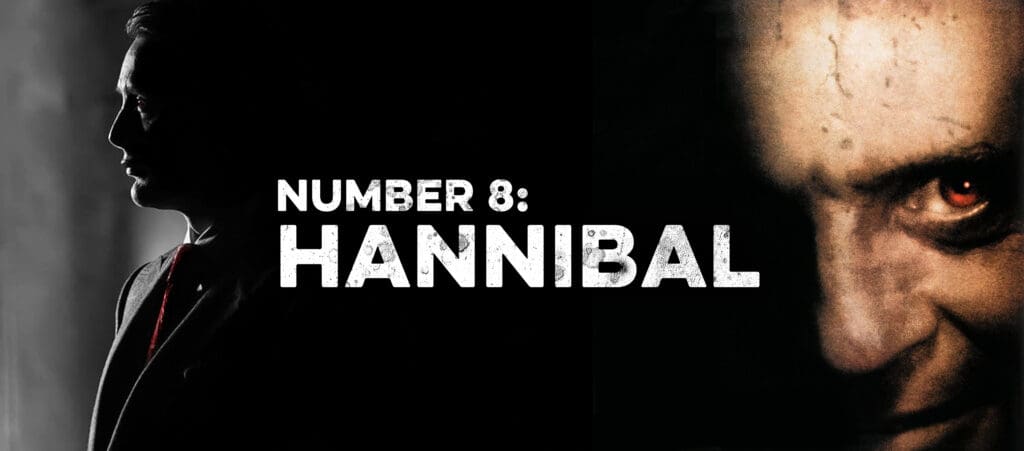
WHAT IT INSPIRED: Creepy serial killers and tense escalation.
Two words: Serial killer. I won’t spoil anything, but Mushroom Blues centers around murdered and disappeared children, and the way that mystery unfolds becomes more and more disturbing. The Hannibal Lecter franchise was so influential upon this aspect of the story.
Hannibal as a character is so thoroughly creepy. Whether it’s Anthony Hopkins in The Silence of the Lambs, Hannibal and Red Dragon, or Mads Mikkelsen in the TV series Hannibal, or the original books by Thomas Harris, this iconic serial killer is so synonymous with dread. There is a quiet menace to Hannibal, one that so effectively ramps up tension across any of his stories. We know what Hannibal is capable of, but the true terror comes from how Hannibal’s mental and physical actions unfold. This was so essential for in creating a mystery that built up slowly, the pieces falling into place and the horror becoming clearer … until it’s already too late.
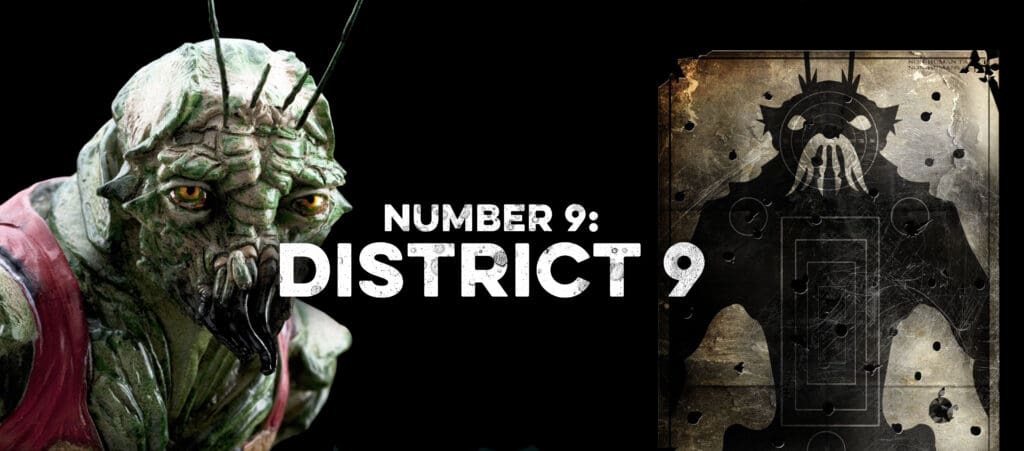
WHAT IT INSPIRED: Strange creatures, alienation and subjugation.
Neill Blomkamp’s 2009 film District 9 is one of those works that hit me so hard when I least expected it. Who was this director? What the hell is this movie about? But the way it takes an alien first contact framework and melds it with themes of xenophobia and social segregation is stunning in its execution. Set in Johannesburg, South Africa, a population of sick and malnourished insectoid aliens arrives over the city. The aliens (nicknamed “prawns”) are confined to ghettos, mistreated and discriminated against. There is a transparent brutality in this display of othering.
When it comes to the fungal people in Mushroom Blues, the native inhabitants of Hōppon, their nation has been invaded by humans from another land. Their capital city, Neo Kinoko, is under military occupation, and they’ve been pushed into ghettos. The fungals scrounge by on mushrooms and rations, experience abuse and racism from humans, and live under the yoke of institutions that don’t give a shit about them—basically, a very unsavory environment to live in. The humans treat them as alien, and this xenophobic otherness seeps into the core of this book. It begs the question: Who is more human, the humans or the aliens?
🍄 ABOUT THE AUTHOR 🍄
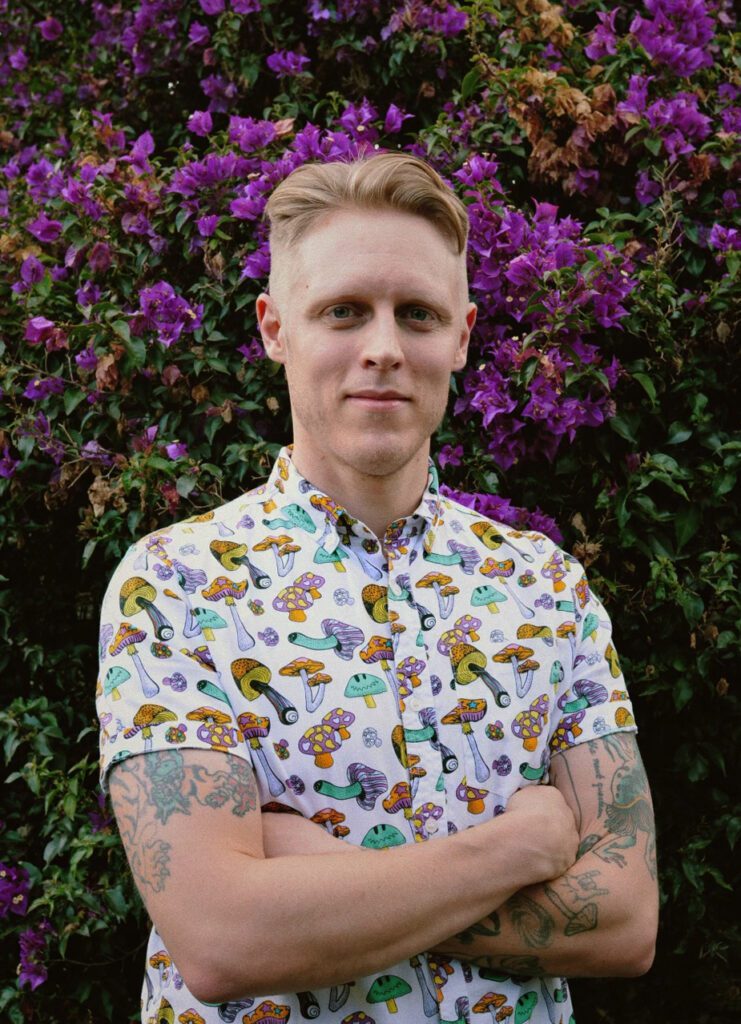
ADRIAN M. GIBSON is a Canadian author, podcaster and illustrator (as well as occasional tattoo artist). He was born in Ontario, Canada, but grew up in British Columbia. He studied English Literature and has worked in music journalism, restaurants, tattoo studios, clothing stores and a bevy of odd jobs. In 2021, he created the SFF Addicts podcast, which he co-hosts with fellow author M. J. Kuhn. The two host in-depth interviews with an array of science fiction and fantasy authors, as well as writing masterclasses.
Adrian has a not-so-casual obsession with mushrooms, relishes in the vastness of nature and is a self-proclaimed “child of the mountains.” He enjoys cooking, music, video games, politics and science, as well as reading fiction and comic books. He lives in Quito, Ecuador with his wife and sons.
Mushroom Blues is his debut novel.
🍄 ‘THE FUNGALVERSE REVIEW’ NEWSLETTER 🍄
Subscribe to Adrian M. Gibson’s mailing list to receive a monthly newsletter featuring the latest happenings in Adrian’s life, writing updates, events and podcast appearances, the newest episodes of SFF Addicts podcast, original art, special promos and more! SIGN UP HERE.
🍄 SOCIAL LINKS 🍄
Website: https://adrianmgibson.com/
Twitter: https://twitter.com/adrianmgibson
Instagram: https://www.instagram.com/adrianmgibson/
Facebook page: https://www.facebook.com/adrianmarcgibson
SFF Addicts podcast: https://linktr.ee/SFFAddicts
SFF Addicts Patreon: https://www.patreon.com/sffaddictspod
YouTube: https://www.youtube.com/c/fanfiaddict
Online Store: https://adrianmgibson.com/shop

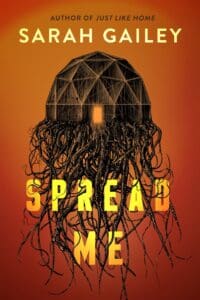
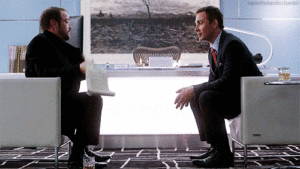

Leave a Reply